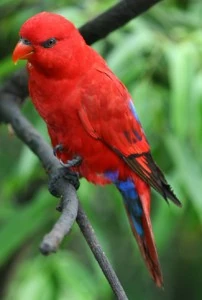| Eos | |
|---|---|
 Red Lory (Eos bornea) | |
| Scientific Classification | |
| Kingdom | Animalia |
| Phylum | Chordata |
| Class | Aves |
| Order | Psittaciformes |
| Family | Psittacidae Loriinae Loriini |
| Genus | Eos |
Eos is a genus of parrots belonging to the lories and lorikeets tribe of the Psittaculidae family. There are six species which are all endemic to islands of eastern Indonesia, most within very restricted ranges. They have predominantly red plumage with blue, purple or black markings. Males and females are similar in appearance.
Their habitats include forest, coconut plantations and mangroves. They gather in flowering trees to feed on nectar and pollen with their brush-tipped tongues. Fruit and insects are also eaten. They make nests in tree hollows generally high in old large trees. Threats to these parrots include habitat loss and trapping for the cagebird trade, and one species, the red-and-blue lory, is classified as endangered.
Description[]
The plumage of Eos lories is predominantly red, set off with blue, purple or black markings. They range in length from 24 cm (9 in) in the blue-eared lory to 31 cm (12 in) in several of the larger species. The bill is orange-red, the irises are reddish to reddish-brown, and the legs are grey. Males and females are identical in external appearance. They have a musky odour, especially noticeable in the black-winged lory, which is retained even in museum skins. Juvenile birds are partly striated owing to feathers with darker or dusky tips, and they have orange-brown to black beaks.
Species in the genus Eos are distinguished from lories in the genus Chalcopsitta by shorter tails and the absence of a bare patch of skin around the mandibles. The Eos genus does not have green plumage, which helps to identify them from some species of other lory genera.
Eos (Ἔως) is Greek for "dawn", referring to the red plumage.
Behavior and Ecology[]
The Eos lories feed on the nectar and pollen of various trees and plants. Very little is known about the diet of most species, but birds have been observed feeding on the flowers of coconuts, Eugenia, coral trees (Erythrina), Canarium, and sago palm (Metroxylon). In addition, they have been observed feeding on unripe fruits of fig trees (Ficus), and insects have been found in the stomachs of at least one species (the red lory). Some species are reported to be nomadic, moving between islands within their range in order to find food. These movements can apparently be daily as well, with the violet-necked lory making daily trips from its main islands to smaller offshore islands.
Status and Conservation[]
Threats to these parrots include habitat loss and trapping for the cagebird trade. For example, between 1983 and 1989 an average of 3,200 red lories were trapped and exported per year, which has apparently led to declines in some parts of its range. The red-and-blue lory is an endangered species, and the black-winged lory is classed as vulnerable. The red-and-blue lory is listed under Appendix I of CITES, banning all trade in wild caught birds, while all other species are listed under Appendix II and require permits for their trade.
Taxonomy[]
The genus was described by German naturalist Johann Georg Wagler in 1832, and is derived from the Ancient Greek eos meaning "dawn", which refers to both the bright red plumage and the eastern distribution of the red-and-blue lory. The closest relatives of this genus are the species in the genus Trichoglossus. The genera Eos, Trichoglossus, Chalcopsitta, and Pseudeos form a single clade within the lories and lorikeets. The cardinal lory (Chalcopsitta cardinalis) has sometimes been placed in the genus.
The Eos genus has six species and several subspecies:
Red Lory (Linnaeus, 1758) (Eos bornea or Eos rubra) Eos bornea bornea (Linnaeus, 1758) Eos bornea cyanonotha (Vieillot, 1818) Black-winged Lory (Bonaparte, 1850) (Eos cyanogenia) Red-and-blue Lory (P.L.S. Müller, 1776) (Eos histrio) Eos histrio histrio (Statius Muller 1776) Eos histrio talautensis (Meyer, AB & Wiglesworth 1894) Blue-streaked Lory (Müller, 1841) (Eos reticulata) Blue-eared Lory (Bonaparte, 1850) (Eos semilarvata) Violet-necked Lory (Boddaert, 1783) (Eos squamata) Eos squamata obiensis, (Rothschild, 1899) Eos squamata riciniata, (Bechstein, 1811) Eos squamata squamata, (Boddaert, 1783)
